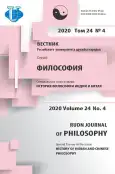Концепция времени в советском неоклассицизме (на примере архитектурного дискурса)
- Авторы: Круглова Т.А.1
-
Учреждения:
- Уральский федеральный университет имени первого президента России Б.Н. Ельцина
- Выпуск: Том 24, № 4 (2020): ИСТОРИЯ ФИЛОСОФИИ ИНДИИ И КИТАЯ
- Страницы: 681-693
- Раздел: ОНТОЛОГИЯ И ГНОСЕОЛОГИЯ
- URL: https://journal-vniispk.ru/2313-2302/article/view/325075
- DOI: https://doi.org/10.22363/2313-2302-2020-24-4-681-693
- ID: 325075
Цитировать
Полный текст
Аннотация
В статье рассматривается процесс смены темпоральных режимов в советской культуре на рубеже 1920-х - и в течение 1930-х гг. на материале архитектуры. Сравниваются концепции времени в конструктивизме и неоклассицизме, так как борьба между ними определила основные векторы художественного развития в реконструктивный период. Проводится анализ дискурса официальной позиции по отношению к основным трендам развития архитектуры в контексте периодизации социалистического строительства, выявляются основания поддержки обращения к классическому наследию. Смена государственно-политических задач (переход от демонтажа старого порядка и ликвидации последствий распада социальной ткани к построению нового социального порядка) задала новые требования к архитектуре как важнейшему способу социальной репрезентации. Новое общество - социализм - трактовалось в конструктивизме, ведущем направлении архитектуры 1920-х гг., в модусе будущего времени. В неоклассицизме 1930-х гг. социализм помещался в модус настоящего времени. Конструктивизм был нацелен на прагматику восстановления социальной ткани и решение текущих задач (массовое жилищное строительство, новая социальная инфраструктура), а также на конструирование будущего социума и человека. В конце первой пятилетки властью перед культурой в целом и перед архитектурой в частности были поставлены другие цели: репрезентация достижений и выражение величия социалистического строительства. Неоклассицизм был призван для увековечивания настоящего положения дел в модусе реального совершенства и превосходства советского социализма над любыми иными форматами социальной жизни. Между временем творения (конструктивизм) и временем свершения (неоклассицизм) образуется пробел, разрыв, который должен быть скрыт. Способом сокрытия темпорального разрыва становятся классические принципы формообразования и образцы ренессансного и русского классицизма, призванные убедительно продемонстрировать, с одной стороны, возможность ускорения и сжатия времени, стремительность достижения идеала, а с другой стороны, обесценить новации, сделать ненужным представление о движении времени в будущее. Учение ведущего неоклассика И. Жолтовского разбирается с точки зрения альтернативы утопической трактовке времени в конструктивизме, как реализующее мифологическое время, в котором исток и финал творения даны одновременно и в модусе вечности.
Об авторах
Татьяна Анатольевна Круглова
Уральский федеральный университет имени первого президента России Б.Н. Ельцина
Автор, ответственный за переписку.
Email: tkruglowa@mail.ru
доктор философских наук, профессор кафедры истории философии, философской антропологии, эстетики и теории культуры
Российская Федерация, 620002, Екатеринбург, ул. Мира, 19Список литературы
- Vyazemceva AG. Iskusstvo totalitarnoj Italii. Moscow; 2018. (In Russian).
- Trencsenyi B. Bunt protiv istorii: «Konservativnaya revolyuciya» i poiski nacional'noj identichnosti v mezhvoennoj Vostochnoj i Central’noj Evrope. In: Antropologiya revolyucii. Colleсted papers. Moscow; 2009. P. 207—241. (In Russian).
- Kruglova TA. «Krasnaya» restavraciya. In: Kruglova T.A. Neskromnoe obayanie socrealizma, ili Sovetskaya hudozhestvennost’. Ekaterinburg. 2005. P. 262—298. (In Russian).
- Kolli NY. «Zadachi sovetskoj arhitektury». Doklad na Pervom vsesoyuznom s’ezde sovetskih arhitektorov. Moscow; 1937. (In Russian).
- Zvagel'skaya VE. Neoklassicizm sovetskoj epohi v pamyatnikah arhitektury Sverdlovskoj oblasti. Ekaterinburg; 2011. (In Russian).
- Han-Magomedov S. Arhitektura Moskvy ot avangarda do stalinskogo ampira. In: Moskva — Berlin. 1900—1950. Moscow; Berlin, Munich; 1996. P. 205—211. (In Russian).
- Teplyakov DA. Koncepciya socialisticheskogo obshchestva v «Krasnoj zvezde» Aleksandra Bogdanova. In: Epoha socialisticheskoj rekonstrukcii: idei, mify i programmy social'nyh preobrazovanij: sb. nauch. trudov. L.N. Mazur (ed.). Ekaterinburg; 2017. P. 71—78. (In Russian).
- Ikonnikov A. Utopicheskoe soznanie i arhitektura XX veka. In: Kartiny mira v iskusstve XX veka. Shtrihi k portretu epohi. Moscow; 1994. P. 56—75. (In Russian).
- Revzin G. Arhitekturnaya teoriya Zholtovskogo. Iskusstvo. 1988;(10):60—64. (In Russian).
- Mannheim K. Ideologie und Utopie. In: Mannheim K. Diagnosis of our time. Transl. by M.I. Levin. Moscow; 1994. P. 7—275. (In Russian).
- Sadovskij YA. Stalinizm kak sledstvie gibeli utopij. In: Epoha socialisticheskoj rekonstrukcii: idei, mify i programmy social’nyh preobrazovanij: Colleсted papers. Ekaterinburg; 2017. P. 389—399. (In Russian).
Дополнительные файлы









